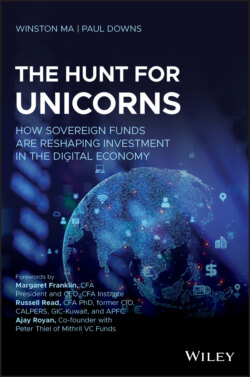Читать книгу The Hunt for Unicorns - Winston Ma - Страница 32
Trillion-Dollar Club
ОглавлениеThe global economy has witnessed the emergence of a new set of key actors over the last two decades – the Sovereign Investors. In this group we include Sovereign Wealth Funds (SWFs) and the very large Public Pension Funds (PPFs), which are active in the global marketplace and have many of the characteristics of SWFs. The concept of SWFs also includes sovereign development funds (SDFs), government established investment vehicles with development objectives.
These Sovereign Investors have become pivotal players in global financial markets thanks to their enormous capital base, and they continue to increase in number, size, variety, and scope. This group of highly heterogeneous funds has different backgrounds, structures, and missions, but they share one ultimate goal: to preserve capital and maximize the return on investments. As such, in this book they are collectively referred to as the Sovereign Investment Funds (SIF).
How much money are we talking about? Tens of trillions of dollars sit in these funds. Table 1.1 shows the top ten sovereign wealth funds ranked by assets under management (AUM). The very top funds manage monies exceeding the GDP of good-sized European countries. If AUM were GDP, they would rank among the top 20 nations.
Table 1.1 Top Ten Sovereign Wealth Funds
Data Source: Sovereign Wealth Fund Institute, March 2020.
| Government Pension Fund of Norway, Europe, $1,108,170,000,000China Investment Corporation (CIC), Asia, $940,604,000,000Abu Dhabi Investment Authority (ADIA), Middle East, $696,660,000,000Kuwait Investment Authority (KIA), Middle East, $592,000,000,000Hong Kong Monetary Authority, Asia, $509,353,000,000GIC Private Limited, Asia, $440,000,000,000National Council for Social Security Fund, Asia, $437,900,000,000SAFE Investment Company, Asia, $417,844,700,460Temasek Holdings, Asia, $375,383,000,000Qatar Investment Authority (QIA), Middle East, $328,000,000,000 |
As is discussed in more detail below, these sovereign investors are derived from different sources and serve different ends. But a common factor is their growth in size and geographic spread. Commonly thought of as a Middle Eastern phenomenon, broadly viewed, the funds are based in much of the developed world and include very large funds from North America, East Asia, and Europe as well as the Gulf. Increased growth is expected to come from other regions, most notably, sub-Saharan Africa, where natural resources may be the source and domestic economic development the objective.
Currently, according to the Sovereign Wealth Fund Institute's (SWFI's) “Top 86 Largest Sovereign Wealth Fund Rankings by Total Assets,” the top ten largest sovereign wealth funds ranked by total assets are as shown in Table 1.1.
Public Pension Funds are important members of the SIF tribe. They are even larger, as the table below indicates; they are global and they are innovative, increasingly focused on tech innovation. GPIF (Japan), NPS (Korea), CPPIB (Canada), and CalPERS (US) are well known in the capital markets for their active investments (see Table 1.2). This combination of characteristics reinforces the perception of SIFs as savvy, silent heavyweights in the world's private and public markets.
Table 1.2 Top Ten Public Pension Funds
Data Source: Sovereign Wealth Fund Institute, March 2020.
| Social Security Trust Funds, North America $2,925,789,929,172Government Pension Investment Fund Japan (GPIF), Asia $1,490,240,000,000Military Retirement Fund, North America $813,555,000,000Federal Employees Retirement System, North America $687,000,000,000National Pension Service of Korea (NPS), Asia $593,192,000,000Federal Retirement Thrift Investment Board, North America $572,370,000,000Zenkyoren Pension Japan, Asia $523,463,576,000Stichting Pensioenfonds ABP, Europe $476,000,000,000Canadian Pension Plan Investment Board (CPPIB), North America $385,634,000,000California Public Employees Retirement System (CalPERS), North America $370,300,000,000 |
Given this enormous concentration of wealth, it is no surprise that these giants have been viewed as economic superheroes, repeatedly turned to in times of crisis: in war, in the global financial crisis, and now in pandemic. Like superheroes, each has a role to play and some have even morphed to encompass additional roles, particularly when, as now, a new crisis arrives on the scene.
And their ranks continue to swell at an increasing pace. Assets under management continue their relentless rise while new funds emerge. The establishment of new funds is not a region-specific trend, as can be illustrated by funds being set up across the globe, including the Hong Kong Future Fund, Holdings Equatorial Guinea 2020, and West Virginia Future Fund. Europe is especially interesting, because Europe traditionally is not a significant player when it comes to sovereign wealth. (The Norway Government Pension Fund (also known as the Oil Fund), managed by Norges Bank Investment Management (NBIM), is considered the world's largest SWF, but it sits outside the European Union.)
There is now a Luxembourg entrant into the SWF world: Fonds soverain intergenerational du Luxembourg, which will invest for many generations to come. Also in Europe, the French, Italian, and Spanish funds, among other nations, emerged as a solution to attract other foreign players to co-invest with them in their respective domestic economies. Even a UK Citizens Wealth Fund has been proposed. But look to sub-Saharan Africa for the next surge of sovereign investors. While Nigeria and Kenya are highlighted in case studies later in this chapter, there are also sovereign funds in Algeria, Angola, Botswana, Ghana, Libya, Morocco, Nambia, and Rwanda. Not to be left behind, others, such as Japan and India, have also joined their ranks.
